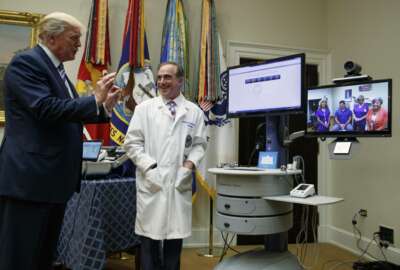
VA official says it’s his mission to re-centralize HR offices
CHCO Peter Shelby wants to consolidate HR offices from 172 to just a few and he said it all begins with developing a standard leadership program
The Veterans Affairs Department has more than 170 human resources offices and more than 200 learning management systems. One VA official said that’s a bit excessive. He’s made it his goal to re-centralize the agency and whittle down the number of offices across the country performing the exact same functions, but differently.
VA is one of the largest agencies in the federal government, so it is a tough job to keep everyone on the same page. However, Peter Shelby, chief human capital officer at VA, said it needs to be done sooner rather than later. He said having a more centralized way of completing “common core” functions across the VA offices would help tremendously.
“Many decades ago one of the secretaries said [we] need agility at the lowest level in [the] organization … so let’s decentralize everything down to the lowest level and give them contracting authority, decision authority. We call that the spaghetti slide, and this is how it operates right now at VA,” Shelby said on Agency in Focus. “So, I’m changing that. We absolutely have to change. There’s no clear line of authority.”
The largest amount of disconnect comes from the lack of consistencies. When faced with a similar dilemma, two HR offices may handle the situation differently. Shelby said it is important for all of the offices to have a standard way of handling things like accommodation, retirement and hiring. One solution to this problem, he said, is consolidating these offices into one capability at a headquarters level.
Different offices do not even operate on the same system. Each one runs on local decision authority, and this is where problems arise for the department as a whole. He said they need to develop a plan where there is a headquarters determining what laws and regulations mean, and how they are going to be implemented. Then they can teach all of the sectors exactly what to do.
Through this initiative, most of the learning management systems will be eliminated. Currently the CHCO is using a TIGER grant to identify and count all of the systems, and their functions. Then, Shelby said, they will work to consolidate them into one system.
His goals are to change decision authority and figure out what the common core functions are across offices.
“How can you do performance management if you have a thousand different standards for leadership? It’s absolutely impossible,” Shelby said at a human resources management event in December. “We’re putting in place a core way of talking about leadership [and] human capital development. And everyone will go through it.”
Leadership is a posture, he said. So now when individuals decide to start a career with the VA, they will be required to learn the standard way of communication and performance — especially those in leadership roles. He said his office wasn’t exempt either.
Development is only 10-to-15 percent of the job of a human capital officer. The rest must be learned by the employee through on-the-job training — such as mentoring, coaching and job training. This training will be different, depending on the area focus. However, the other 75-80 percent needs to be standard across the different sectors.
“The first thing I’m doing is consolidating the authorities and working very closely with [the Veterans Health Administration, Veterans Benefits Administration and National Cemetery Administration],” he said. “And I’m the first one impacted by consolidating of capabilities. I got rid of my own HR office and now everybody in Washington, D.C. that works for the VA is serviced by three different HR offices across the country.”
These offices are located in Mississippi, Texas and Kansas. Shelby said he hopes to consolidate down to just a few field offices, and not 172. VA HR consolidation will begin at the bottom and work its way up. This is different than many other reorganization projects.
“Form follows function,” Shelby said. “I don’t know what the function is going to be, but we’re going to change the way we think about how we do HR and deliver those services.”
The VA currently also has more than 40,000 vacancies across the department. Shelby said this leadership training could help VA to identify key talent within the agency to potentially move into leadership roles. Then, they can recruit others to fill those lower positions.
“When everybody speaks the same language around leadership and performance, you can truly differentiate between your top, your middle and your bottom performers. Now, I can start putting into my talent management,” he said. “In getting that first piece of it done, it feeds everything else you do with human capital from soup to nuts, you’ve got [a] continuous flow talent pipeline.”
He said every person who works in the VA — from custodian to doctor — is essential. And if even one doesn’t show up to do their job, the whole agency is affected.
Shelby said the VA HR office needs to operate more like the military: consistent and disciplined.
Copyright © 2024 Federal News Network. All rights reserved. This website is not intended for users located within the European Economic Area.
Steff Thomas is a digital editor at Federal News Network.
Related Stories





